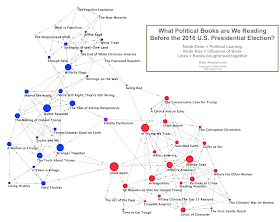I have been mapping people networks in organizations and communities since the late 1980s. In the late 1990s I began mapping networks of artifacts that people interacted with -- like documents & publications. A publication network is a proxy network for the human network that creates it, via personal choices. We don't see the human network, but we understand human choices, and see human clusters, by examining human artifact networks that emerge from people's daily activities. Your choices reveal who you are, and who you are like.
One day, while browsing through some books-of-interest on Amazon, I started to wonder how these books are connected based on our choices. I was not looking at the content, sentiment, or word analysis in the publications, but was interested in how these objects were socially connected -- who purchased and read similar books? What is the network of books based on purchases by customers? Amazon made it easy to answer this question by offering data on "also-bought" books for each book they sold -- people that bought X also bought Y and Z.
At the time, I was writing a regular series of columns for the IHRIM Journal called "Working in the Connected World." I wrote about how our documents and publications are connected in patterns, based on our choices.
Several years later I became fascinated with applying these insights to political books in the USA. In the early 2000s U.S. politics was dividing into clear and distinct clusters of Red(Conservative) and Blue(Progressive). In 2003 I mapped my first political book network. It is illustrated in Figure 1 below. It seemed that the behavior of Amazon customers closely matched the countrywide patterns of political polarization. The NY Times wrote an article about the analysis. Here are the political book networks from the last two U.S. presidential elections.
 |
| Figure 1 |
Now, in 2016, we are on the verge of another presidential primary season. I decided to do another map. By now all of the major candidates had a book out about their personal lives candidacy. It would be interesting to see if their place in the book network reflected their place in the political poll rankings.
Figure 2 below shows the political book network as of the end of January 2016. Two books are linked if they often sold together, and book nodes are colored by political orientation: red(conservative), blue(progressive) and purple(both/neither). We drew asymmetric links between books with an arrowhead indicating which book was indicated as an also-bought to which other book. A --> B means that buyers of book A also bought book B. Depending on the volume of each book sold (A, B) we may not expect both books to be also-boughts for each other. Some connections are one-way only, with the lower volume seller usually pointing to the higher volume seller.
Figure 2 below shows the political book network as of the end of January 2016. Two books are linked if they often sold together, and book nodes are colored by political orientation: red(conservative), blue(progressive) and purple(both/neither). We drew asymmetric links between books with an arrowhead indicating which book was indicated as an also-bought to which other book. A --> B means that buyers of book A also bought book B. Depending on the volume of each book sold (A, B) we may not expect both books to be also-boughts for each other. Some connections are one-way only, with the lower volume seller usually pointing to the higher volume seller.
 |
| Figure 2 |
What was most surprising was seeing several blue books also pointing to the dominant red book: Trump's Crippled America. Especially noticeable were two key books about the top two Democrats -- Bernie Sanders and Hillary Clinton. Why would people who bought positive books about Clinton and Sanders also buy Trump's book??? See these surprising links hi-lited in blue in Figure 3 below. I understand why the Democrats would want to understand the poll leader of the opposition, but why buy his book? I remind the reader that this Amazon data shows purchase data, not interest data.
 |
| Figure 3 |
Another view of the data, this time from IBM's Watson Analytics, shows us a similar pattern -- Trump's book is dominant. Figure 4 is a word cloud of the book titles in our data set. The larger the title, the more other books point to this one -- it is a more popular "also bought" title. Network analysts call this measure "in-degrees."
 |
| Figure 4 |
Update December 2016: Finally, we look at the network of books right before the 2016 presidential election shown in Figure 5. Here we see that Trump's book (renamed from "Crippled America" to "Great Again" since the beginning of the year) is still the key book in the network. Just prior to the election, Amazon readers show a greater interest in this Trump book than in any other political book. Was this consumer behavior a leading indicator of his election victory on November 8, 2016 ???
 |
| Figure 5 |
No comments:
Post a Comment